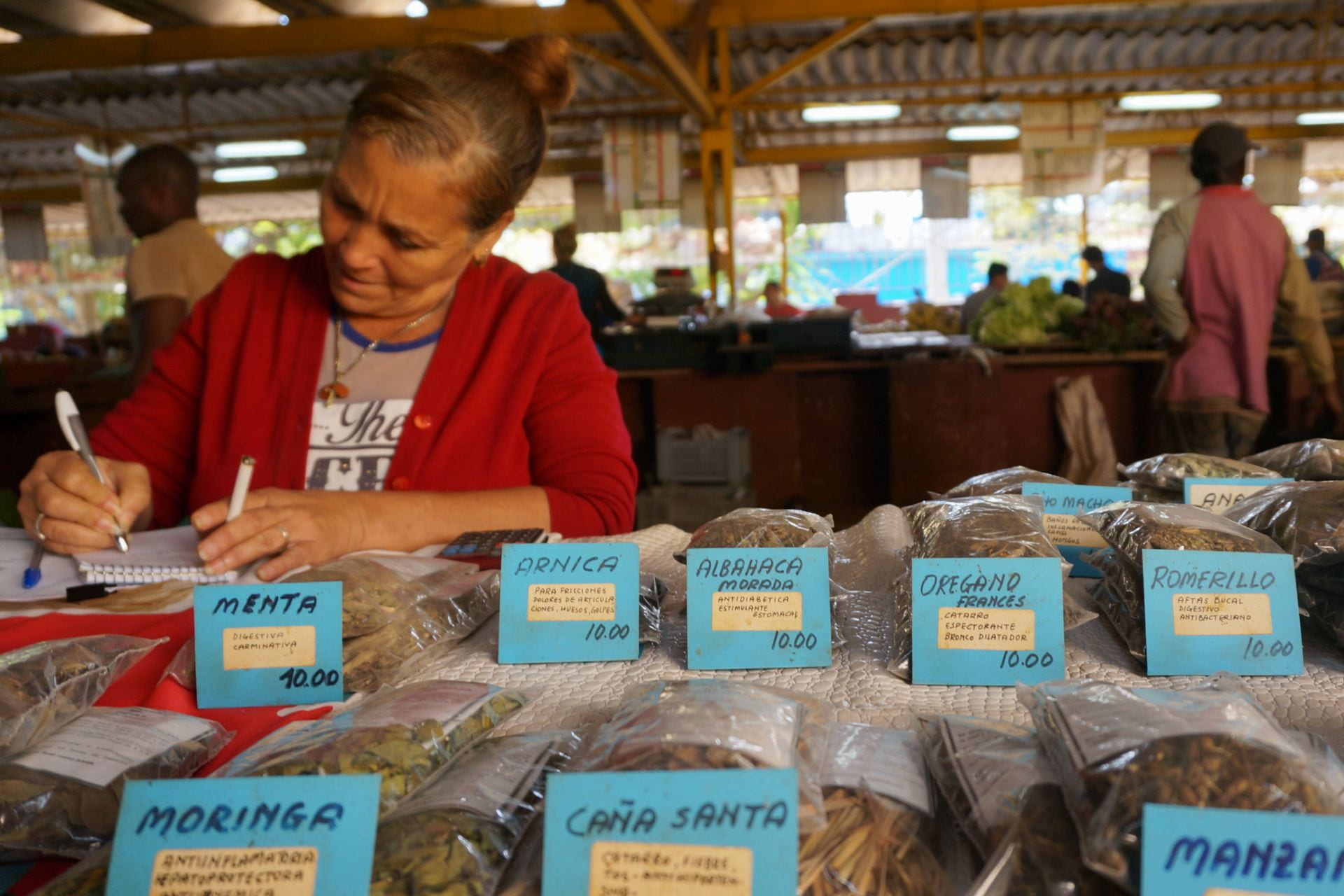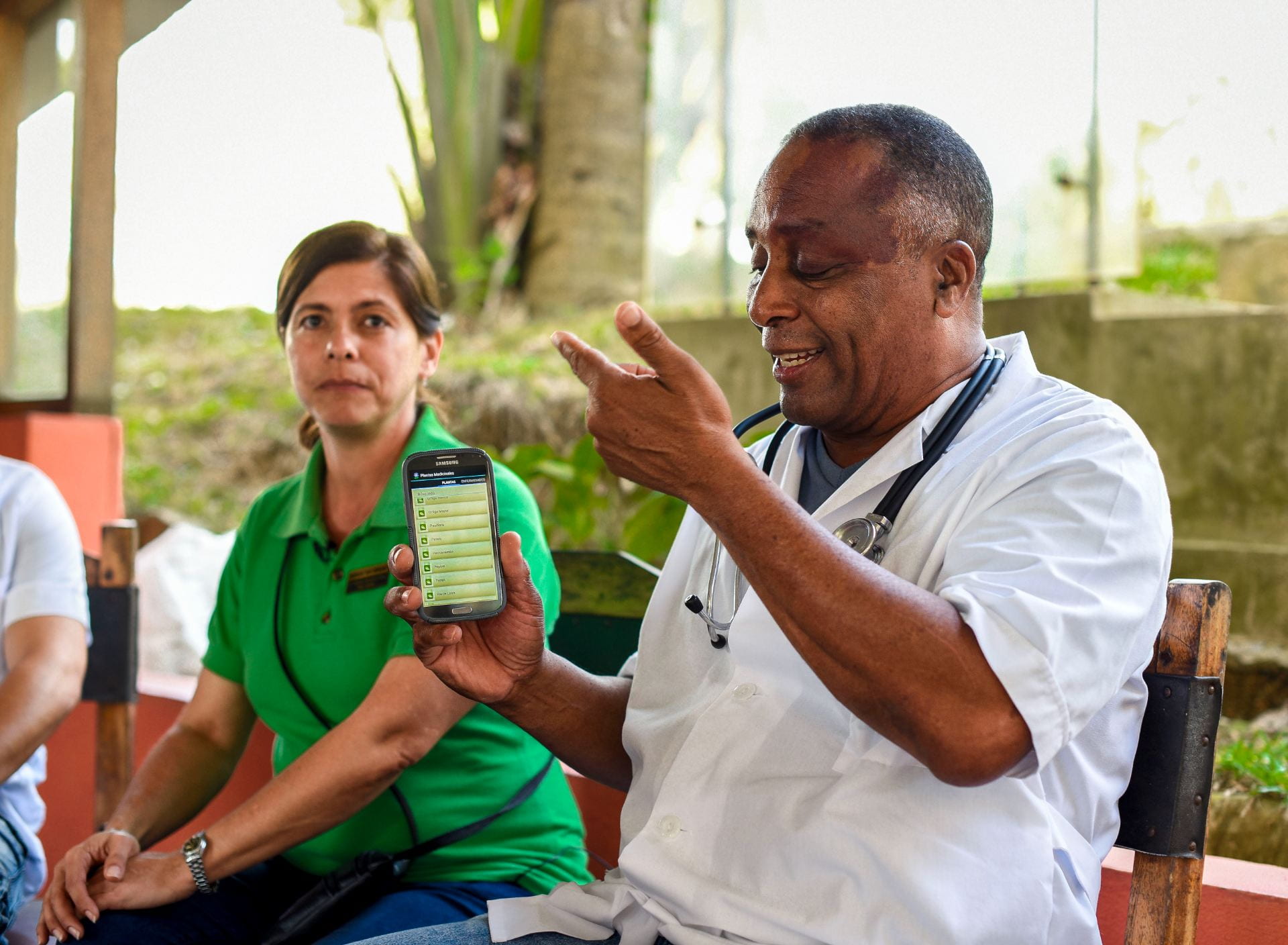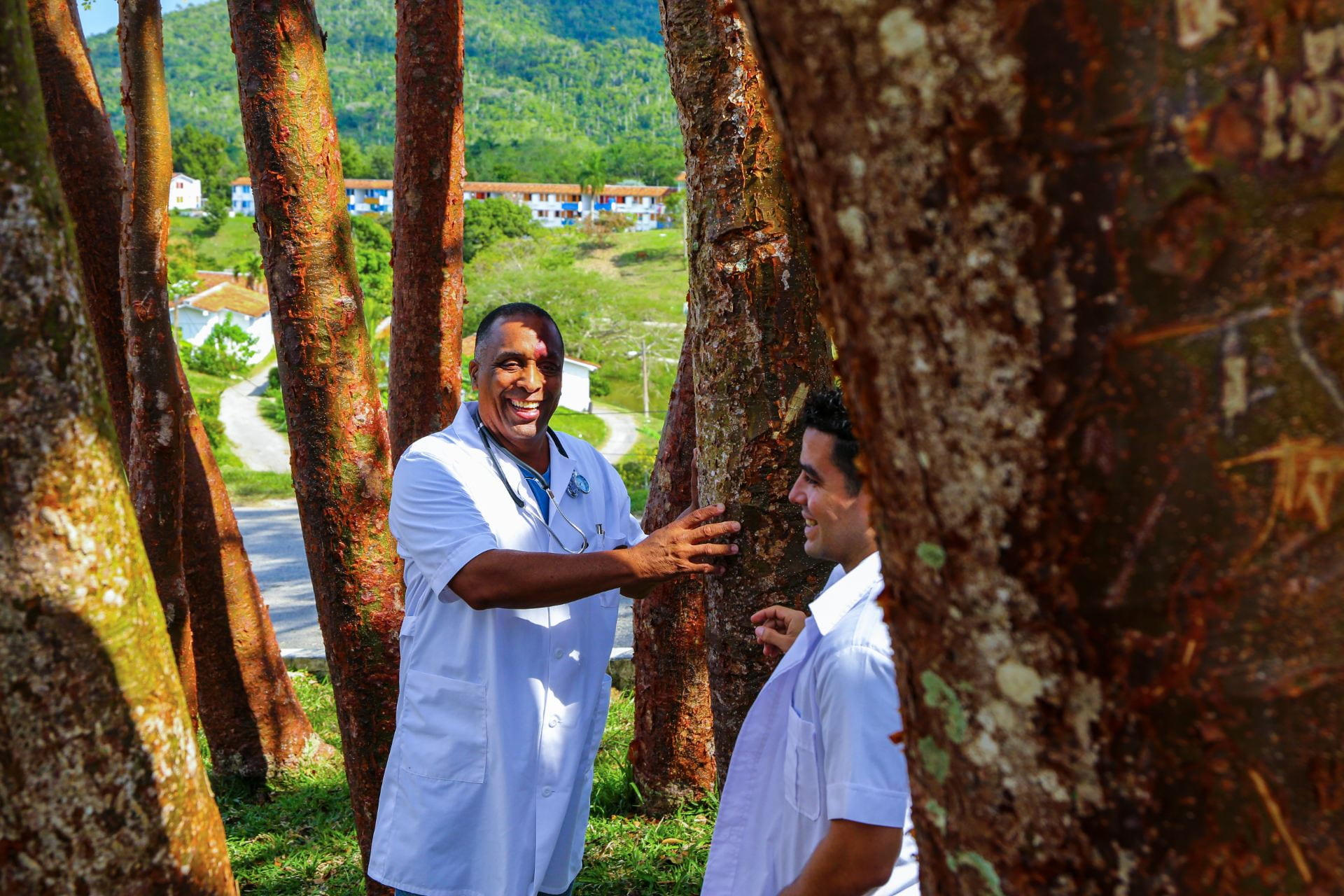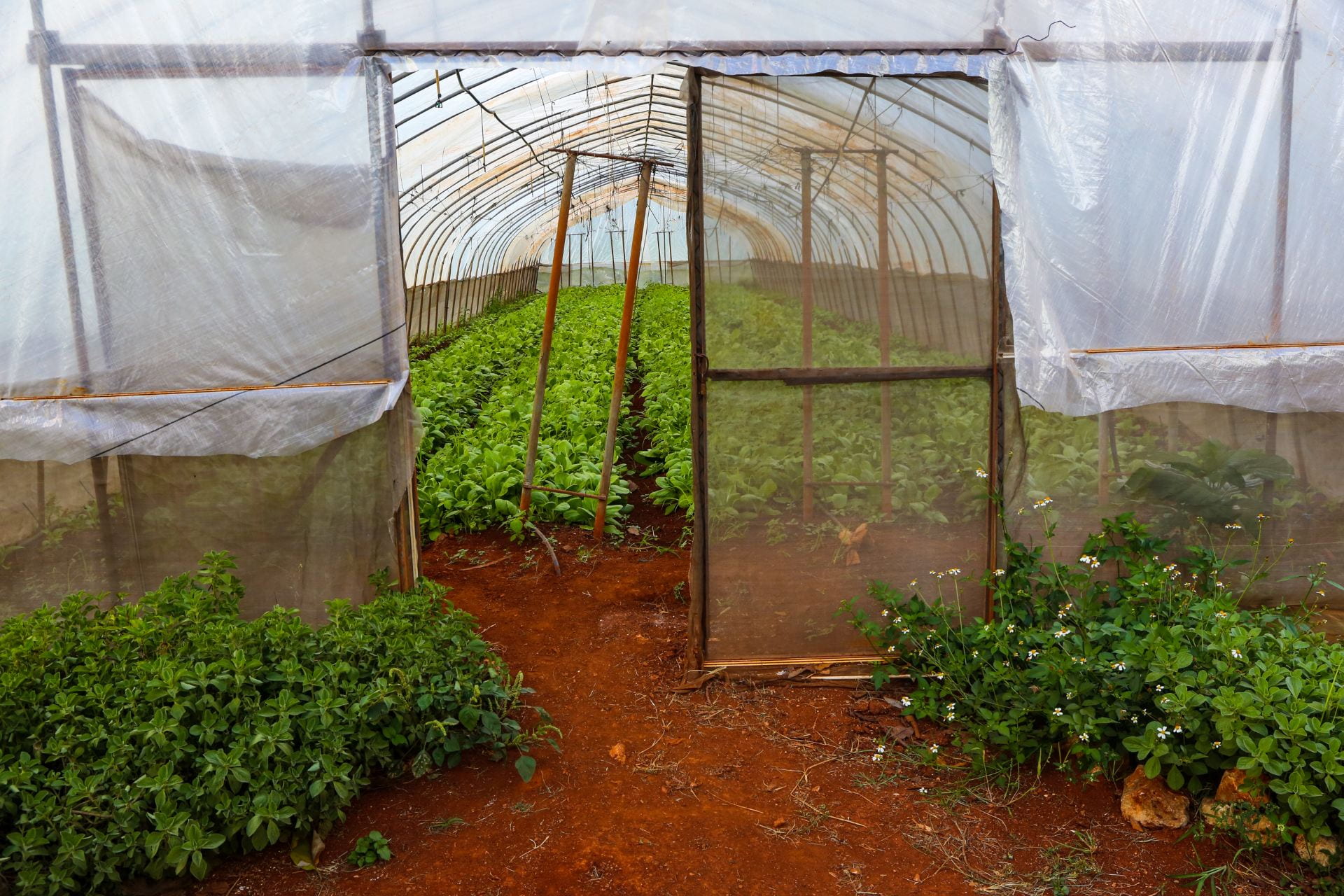Cuban doctors go back to their roots for plant-based remedies

By Seamus McAvoy
HAVANA, Cuba – Just off of Avenida 23, one of Havana’s busiest streets, lies a small shop, its storefront minimally decorated like most others in communist Cuba. The interior is organized like a small jewelry store, with a glass countertop display case separating patrons from a woman in a lab coat, darting in and out from the back room.
Yieve Nieves Pino is the only person sitting in two dozen chairs set up to form something of a waiting area. Pino, 53, has come to this pharmacy to see the doctor regarding the stomach issues that have been bothering her for some time.
But the shelves that line the back wall are not stocked with the sort of pills and ointments and salves that a typical dispensary would have. Instead, they’re filled with bags and bottles of various forms of the drumstick tree, called “moringa” in Spanish.
“I’ve never used natural medicine before, but everyone tells me it’s very effective, and that’s why I’m here,” says Pino through a translator. “I just didn’t need it before now. But this is obviously a type of medicine that is much healthier and much better for the body.”This pharmacy only sells traditional medicine — what would be called “alternative medicine” in the States. That is, natural drugs derived from plants, herbs, roots and trees using knowledge passed down through the generations. There are many more like it around Havana, where drugs created with expensive and sophisticated technology are much harder to come by. In fact, most Cubans have no choice but to consult traditional medicine first before seeking further treatment.
Which is not to say that Cubans view it as inferior. Indeed, the U.S.-imposed embargo (referred to as “el bloqueo” on the island) is comprised of numerous economic sanctions that greatly limit access to a full spectrum of goods and amenities. In spite of this, Cuba’s health system is regarded as an strong example of cost-effective care, and American doctors and researchers have started to visit with Cubans to learn about their ancient yet effective ways.
“Remember that in Cuba with the collapse of the Soviet Union, many things disappeared, and the pills disappeared too,” says Isis Salcines, who works on an organic farm in Havana that specializes in growing medicinal plants. “Many of the doctors had to [transition] the natural medicine.” As doctors began focusing more on the use of traditional medicine, the Cuban people had to respond as well. The medicinal benefits of certain plants were passed down from parents to children within the family, but such knowledge has made its way into more formal institutions like the education system.“There’s actually a class that every kid here takes in elementary school, called ‘The World We Live In,’” says Yoandra Adelá, a general practitioner at a Havana hospital, through a translator. “In every elementary school you’re going to find a small greenhouse where kids plant and farm medicinal plants, and they are taught different uses they have as well as the healing properties of each one.”
In Cuba, the most commonly grown plants often correspond to the most common ailments, and their uses have become a basic component of education. In class, students would learn about different varieties of mint, used to cure indigestion and diarrhea. Or “mejorana,” what Americans would call oregano, which is used to treat coughs, asthma and colds. Camomile, called “manzanilla,” is used to treat stomach ailments, cramps and fevers.
Derivatives of the medicinal tree moringa can be found everywhere, especially within pharmacies of traditional medicine like the one Pino is visiting. On that day were a number of large bags labeled “hojas secas moringa,” or dried moringa leaves, and “polvo de hojas secas moringa,” or dry moringa leaf powder. Smaller bags full of pill-shaped tablets and Advil-shaped bottles include moringa in their labels as well, used to treat fevers, rheumatism, muscle pain, liver inflammation, cystitis and even certain tumors. Like so many Cubans, Pino says she learned about traditional medicine from her mother. “There are lots of options,” she says, still waiting, but hopeful that the leafy deciduous, known here and all over the world as the “moringa miracle tree,” will soon make her stomach aches go away.
A pharmacy in every backyard
In Las Terrazas, an eco-community and biosphere reserve located about 50 miles outside of Havana, residents have access to medicinal plants right in their backyard — literally. Most families grow between five and seven plants in community gardens, often populated with herbs to treat common illnesses like stomach problems or skin irritations.
Some plant-based remedies are utilized here to treat more complicated health problems. Idalmis Pérez, a tour guide and resident of Las Terrazas, relies on a decoction of “palo de Brasil,” a small hillside plant with a thick, woody trunk, to treat her kidney problems and high blood pressure.
“You cut [the bark], but it has to be the size of your hand,” Pérez says, barely audible as a tourist whirrs by on the zipline that spans a nearby lake. She extends her fingers and points to the distance between thumb and pinky, referring to the proper dosage. “I cannot use yours because it’s not the same as mine.”
Pérez says she then cuts away the wood from the bark and places it in water, which immediately turns the color of a dark red wine. After letting it rest for about three hours, it’s ready to be consumed.
As she strolls through the winding walkways of Las Terrazas, Pérez is able to point out a number of medicinal plants along the car-less roads, where chickens and dogs roam free. She turns away after examining for a moment the vibrant yellow flower of “marilope,” used to treat skin conditions. “Everywhere you walk around, you have a plant that you can use,” says Pérez. Access to medicinal plants that can treat everyday ailments helps Cuba sustain its highly centralized health care structure. The island has 67 physicians per 10,000 people compared to just 24 per 10,000 in the United States, according to the most recent data from the World Health Organization. Here local doctor-nurse teams called “consultorios” are available in every community.
But at Las Terrazas, the approximately 1,200 residents of the eco-community rely on the service of just two physicians. Dr. Rodobaldo Pedroso, the more senior of the two, has been working in Las Terrazas for 32 years after marrying into the community — which is typically the only way to become a resident other than being born there — and is a proponent of traditional medicine.
“I know if any of the plants behind you are poisonous,” says Pedroso through a translator as he sits at the open-air community coffee bar, motioning to the nearby hillside. “But you can use them in a certain way, we just have to find out how to use them […] we have to make research, we have to study.”
A communal green space lies in the middle of Las Terrazas’ central courtyard, surrounded by the apartment-style houses typical within the community. Dozens of trees with bold, crimson bark fill the miniature forest, and Pedroso explains that they too have fantastic medicinal benefits. Nicknamed “the tourist tree” for its red, peelable bark, the “gumbo-limbo” of the turpentine family is utilized to treat colds or cure skin infections.
Research into traditional medicine has increased on the island over the last decade, after a resolution passed in 2009 by the Cuban government set up a legal framework for its development and use. Through the resolution, the Ministry of Public Health has begun to implement the use traditional medicine through a variety of different programs. The Ecological Research Center for Sierra del Rosario Reserve, located in Las Terrazas, is one such institution.
“They are in charge, through many people, about making research for the plants, and the use of those plants,” says Dr. Rafael Chamizo Gonzalez, the junior doctor in Las Terrazas, through a translator. “Then they take the list of those plants and send it to hospitals or clinics, where they can use them and try to find the plants.”
To help combat a lack of healthcare resources around the island, employees at the research center go twice a week to schools around the country to work with students as young as 8 to teach them about the plants that can be used as medicine.
Cuba has also taken advantage of developments in technology. Information about various types of medicinal plants including their names, appearance and benefits have been compiled into a smartphone app now available to all Cubans, which Pedroso demonstrates while admitting it is a resource he sometimes has to refer back to. Education policies and resources like these are some of the reasons why the importance of traditional medicine has become ingrained in Cuban culture.
“[The embargo] might have been one of the reasons why our health care ministry encouraged the development of the pharmaceutical industry,” says Adelá, who specializes in urgent and emergency room care at a Havana hospital. “But it has been already proved by years, the effect of herbal medicine as a treatment for many diseases. And of course they have their side effects, but there are fewer than in modern drugs.”
Production of traditional medicine

While the residents of Las Terrazas are mostly able to sustain their traditional medicine supply through community gardens, urban-dwelling Cubans don’t have the room or access to green space necessary to grow a variety of different plants.
Instead, they may come to one of many agricultural markets around Havana called “mercados agropecuarios” that feature local produce, meats and typically a stand dedicated to pre-packaged medicinal plants available for purchase.
“Moringa is the most important herb, but they’re all important,” says Rosa Maria León Castro through a translator. She operates a traditional medicine stand on Avenue 19 in Vedado. “There are people that think it cures better, and that it’s more natural.”
Castro first learned about the many uses of medicinal plants about seven years ago from a doctor specializing in biology, and now contracts with different local herb properties to keep her stand stocked with the essentials. She says that typically, Cubans will come by before they get sick to stock up on the plants they’re unable to grow themselves.
This market is larger than the other ones nearby, where only a few planters of oregano could be found in the traditional medicine section. Here, local Cubans bustle around the horseshoe-shaped walkway as vendors — colorfully stocked with ample fruits and vegetables — populate the inner and outer rings of the open-air structure.
But because they are not state-run, these street markets are often too expensive for Cubans to rely on consistently. They instead may consult their community doctor or local polyclinic once they feel ill for recommended treatment, and again, traditional medicine is usually the first route they take.
In order to keep up with demand at polyclinics and pharmacies of traditional medicine, government-owned farmland like the kind Salcines works is dedicated not only to the production of food, but also of medicinal plants to be refined for consumption.
“This situation with the food and the natural medicine was not for conviction, it was for necessity,” says Salcines regarding the “Special Period,” a time of severe economic impairment in Cuba that coincided with the collapse of the Soviet Union. “Maybe in the United States you never had this problem […] and maybe you want to only use natural medicine because it’s in the fashion, you want to have it natural. But in that moment, it was not for fashion or conviction, it was for necessity.”
Before this increase in demand, only a small portion of the farmland, left to Salcines by her father, was used to grow traditional medicine. This miniature botanical garden mostly consisted of “tilo,” a type of water-willow that is commonly used as a sleep aid by elderly Cubans.
Production has been expanded to include common medicinal plants like oregano, aloe vera, mint and of course, moringa. The farm also grows noni, a tree in the coffee family known for the bleu cheese-smell of its fruit, as an antioxidant and to fight inflammation.
Salcines says that in tropical areas like Cuba, illnesses like the flu, stomach problems or diarrhea can be common. In turn, many different plants are cultivated to treat these ailments while both doctors and civilians try to utilize them before resorting to pills or other forms of modern medicine. She jokes that she tells Americans her polyclinic is like “my Walgreens or CVS.”
Cuba’s investment in the future of traditional medicine as a backbone of the healthcare system is evident, but Salcines is still concerned over its future on the island. She stresses that “it’s impossible” to simply record the knowledge of traditional medicine specialists because of the importance of experience and practice in the field, and she feels as though Cuba’s youth is skeptical of its effectiveness. “It’s very sad because you can see these men have close to 80 years, the young people don’t want to know nothing about the medicinal plant,” says Salcines, who has two adolescent sons. “And these men, when they have to go, what happens with all of this knowledge?”
Traditional medicine and Santería

Indeed, though, there is another community on the island that is heavily invested in the use of traditional medicine beyond its place in a growing bio-pharmaceutical industry. Followers of Santería, a religion that dates back to Cuba’s colonial past and blends Spanish Catholicism with Yoruba traditions, incorporate traditional medicine into their practices for both medicinal and spiritual benefits.
This means that the lines between ritual practice and medicinal practice are often blurred, or combined into the same ceremony.
“Most of all, the healing is done through the herbal use,” says Steve Quintana, a Cuban-born “Santero” who now lives in Lynn, Massachusetts. “The other part is the practice of the religion, and they are two different things. We use the herbs to centralize and purify all the work that we do, but at the same time it is a healing system.”
Santeros like Quintana, 79, who live in Cuba are prohibited from talking explicitly about their use of medicinal plants, unless it’s with another Santero.
Quintana is also known as an “Iyalocha,” or a member of Santería who has brought others into the religion through initiation. He still works out of his home, called a “temple” by his clients, who come to him for healing consultations as well as spiritual guidance.
While plants like mint, oregano or chamomile are used to treat more common illnesses within the practices of Santería, many rituals require the use of stronger herbs with more elaborate preparations. To craft the “ozain,” a plant-based concoction with spiritual power, the presence of an “oriate” and “ozainista” is required. The oriate is a priest who directs the ceremonies, while the ozainista is a priest familiar with the herbs and associated prayers.
The religion places a special focus on the purification of the blood in order to treat diseases like high blood pressure or diabetes, which are easy to treat with the traditional resources available in Cuba but present a problem for followers of Santería in the United States, where the same laxatives and purifiers are more difficult to come by due to harsher growing conditions and lower demand.
“It’s not just the ones you can find in the drug store in the grocery, that is for very mild symptoms,” says Quintana. “The strong herbs that we can find to purify blood and to clean up the person who has the sugar in the body, we have to go into really very deep parts [of southern America] to get the herbs.”
Diuretics like scutch grass, yellow nutsedge or sicklepod won’t be found in American grocery stores, but are implemented into the practice of Santería for their cleansing properties.
The spiritual rituals of Santería are separate from the healing properties of the utilized plants, but the two are always connected — on the island and in the States. Quintana says that this relationship differentiates the religion from the practice of the “curanderos,” native healers from other parts of Latin America.
“They solve problems with herbs, that is one of the connections that we do have,” says Quintana. “But they are not using the rituals, we do use the African practice of religion, and it’s accommodating the practice of the South American with the African. The religion tells us what kinds of herbs to use.”
Interest from abroad

Cuba’s expertise with traditional medicine and its reputation in using it effectively is gaining the attention of foreign medical students.
Located in western Havana is the Latin American School of Medicine, or ELAM in Spanish, which is attracting more foreign students every year to study at its medical facilities. Education there is free, and while ELAM presents an alternative for students unable to incur the tens or hundreds of thousands of dollars in debt that is often necessary to attend medical school in the United States or elsewhere, the price tag isn’t the only draw.
“There are thousands of students at that school and they’re from all over the world,” says Daniel Skinner, a health policy professor at Ohio University’s Heritage College of Osteopathic Medicine. “And it doesn’t seem that the students at ELAM are students that are going there just for cost. Many of them go because they want to train in Cuba, there’s something special about the approach and the culture.”
Skinner brought students from Ohio University’s College of Health Sciences and Professions to visit Cuba in 2017 and 2019 as part of a comparative health program, seeking to explore the structure and organization of an alternative health care system that he describes as “a very rational approach to medicine.” In an upcoming paper to be published in the Journal of Health Care for the Poor and Underserved, Skinner observes the family-and-community-oriented structure as one to be learned from.
And perhaps this structure isn’t the only lesson to glean from Cuba’s system. In the United States, antibiotic and antimicrobial resistance effects as many as 2 million people per year according to the Centers for Disease Control, leaving some to turn toward types of traditional medicine practiced today in Cuba.
“We met a lot of people who would just pick things up, botanical gardens and things like that, and they were very well-versed in how to treat everyday issues,” says Skinner. “There was clearly a lot more on the ground knowledge […] and it seems like there’s more of an interest in it, a cultural direction toward that.”
Skinner shares that during a visit to one of Cuba’s polyclinics this Spring, his students were struggling to find an American equivalent in the health care system while talking to the physicians on staff.
“I said ‘You’re sitting in a space that we literally don’t have in the United States,’” says Skinner. “The polyclinic is unique to the Cuban model, or at least not something we have in the United States.”
